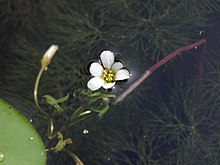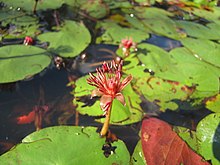Cabombaceae
| Cabombaceae Temporal range: (likely) Mid-Cretaceous–Present
| |
|---|---|

| |
| Flowering Cabomba caroliniana | |

| |
| Flowering Brasenia schreberi | |
| Scientific classification | |
| Kingdom: | Plantae |
| Clade: | Tracheophytes |
| Clade: | Angiosperms |
| Order: | Nymphaeales |
| Family: | Cabombaceae Rich. ex A.Rich.[1] |
| Genera | |
| |
The Cabombaceae are a family of aquatic, herbaceous flowering plants. A common name for its species is water shield.[4] The family is recognised as distinct in the Angiosperm Phylogeny Group IV system (2016). The family consists of two genera of aquatic plants, Brasenia and Cabomba, totalling six species.[5]

Distribution
[edit]The Cabombaceae are all aquatic, living in still or slow-moving waters of temperate and tropical North and South America, Europe, Asia, Africa, and Australia. Although found on all continents but Antarctica, the plants tend to grow in relatively restricted ranges.[6]
Fossil record
[edit]The family has an extensive fossil record from the Cretaceous with plants that exhibit affinities to either the Cabombaceae or Nymphaeaceae occurring in the Early Cretaceous.[6]
One such likely Cretaceous member is the genus Pluricarpellatia, found in rocks 115 million years old in what is now Brazil.[2] Scutifolium jordanicum David W.Taylor, G.J.Brenner et S.H.Basha has been described from the Lower Cretaceous of Jordan.[7] Garasbahia flexuosa Krassilov et Bachia has been described from the mid-Cretaceous of Morocco.[8]
Taxonomy
[edit]Publication
[edit]The family Cabombaceae Rich. ex A.Rich. was first published in 1822 by Louis Claude Richard, but initial description did not satisfy the requirements for valid publications. The family then was validated by Achille Richard.[9]
Taxonomic history
[edit]The APG system of 1998 included this family in the water lily family Nymphaeaceae, as did the APG II system, of 2003 (optionally). The APG III and APG IV systems of classification separated the family Cabombaceae from the family Nymphaeaceae.[10][11][12] The family is part of the order Nymphaeales, which is one of the most basal flowering plant lineages.
References
[edit]- ^ Angiosperm Phylogeny Group (2009), "An update of the Angiosperm Phylogeny Group classification for the orders and families of flowering plants: APG III", Botanical Journal of the Linnean Society, 161 (2): 105–121, doi:10.1111/j.1095-8339.2009.00996.x, hdl:10654/18083
- ^ a b Stevens, Peter F. "Cabombaceae". APWeb. Retrieved 2013-12-01.
- ^ Wang, H., & Dilcher, D. L. (2006). "Aquatic angiosperms from the Dakota Formation (Albian, Lower Cretaceous), Hoisington III locality, Kansas, USA." International Journal of Plant Sciences, 167(2), 385-401.
- ^ Watson, L.; Dallwitz, M. J. "The families of flowering plants, Cabombaceae". Retrieved 2012-12-01.
- ^ Brgaard, Marian (1991). "The genus Cabomba (Cabombaceae) - a taxonomic study". Nordic Journal of Botany. 11 (2): 179–203. doi:10.1111/j.1756-1051.1991.tb01819.x.
- ^ a b Friis, Else Marie; Crane, Peter R.; Pederses, Kaj Raunsgaard (2011). Early Flowers and Angiosperm Evolution. Cambridge University Press. 9781139123921.
- ^ Taylor, D. W., Brenner, G. J., & Basha, S. D. H. (2008). "Scutifolium jordanicum gen. et sp. nov.(Cabombaceae), an aquatic fossil plant from the Lower Cretaceous of Jordan, and the relationships of related leaf fossils to living genera. American Journal of Botany, 95(3), 340-352.
- ^ Krassilov, V.; Bacchia, F. (2013-03-01). "New Cenomanian florule and a leaf mine from southeastern Morocco: Palaeoecological and climatological inferences". Cretaceous Research. 40: 218–226. doi:10.1016/j.cretres.2012.07.005. ISSN 0195-6671.
- ^ "Cabombaceae Rich. ex A.Rich". Plants of the World Online. Royal Botanic Gardens, Kew. Retrieved 20 December 2023.
- ^ Iles, W.J.D.; Lee, C.; Sokoloff, D.D.; Remizowa, M.V.; Yadav, S.R.; Barrett, M.D.; Barrett, R.L.; Macfarlane, T.D.; Rudall, P.J.; Graham, S.W. (2014). "Reconstructing the age and historical biogeography of the ancient flowering-plant family Hydatellaceae (Nymphaeales)". BMC Evolutionary Biology. 14 (1): 102. doi:10.1186/1471-2148-14-102. PMC 4030046. PMID 24884487.
- ^ Saarela, J.M.; Rai, H.; Doyle, J.; Endress, P.; Mathews, S.; Marchant, A.; Briggs, B.; Graham, S. (2007). "Hydatellaceae identified as a new branch near the base of the angiosperm phylogenetic tree". Nature. 446 (7133): 312–315. Bibcode:2007Natur.446..312S. doi:10.1038/nature05612. PMID 17361182. S2CID 4415881.
- ^ Angiosperm Phylogeny Group (2016). "An update of the Angiosperm Phylogeny Group classification for the orders and families of flowering plants: APG IV". Botanical Journal of the Linnean Society. 181 (1): 1–20. doi:10.1111/boj.12385. ISSN 0024-4074.
Further reading
[edit]- Simpson, M.G. Plant Systematics. Elsevier Academic Press. 2006.
External links
[edit] Data related to Cabombaceae at Wikispecies
Data related to Cabombaceae at Wikispecies
